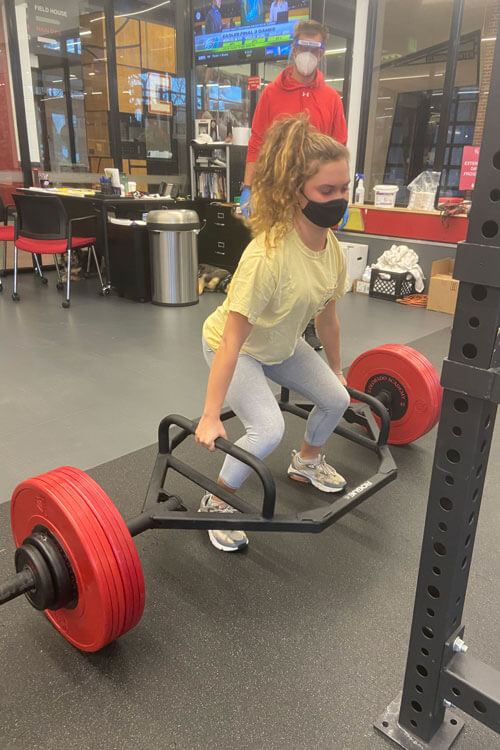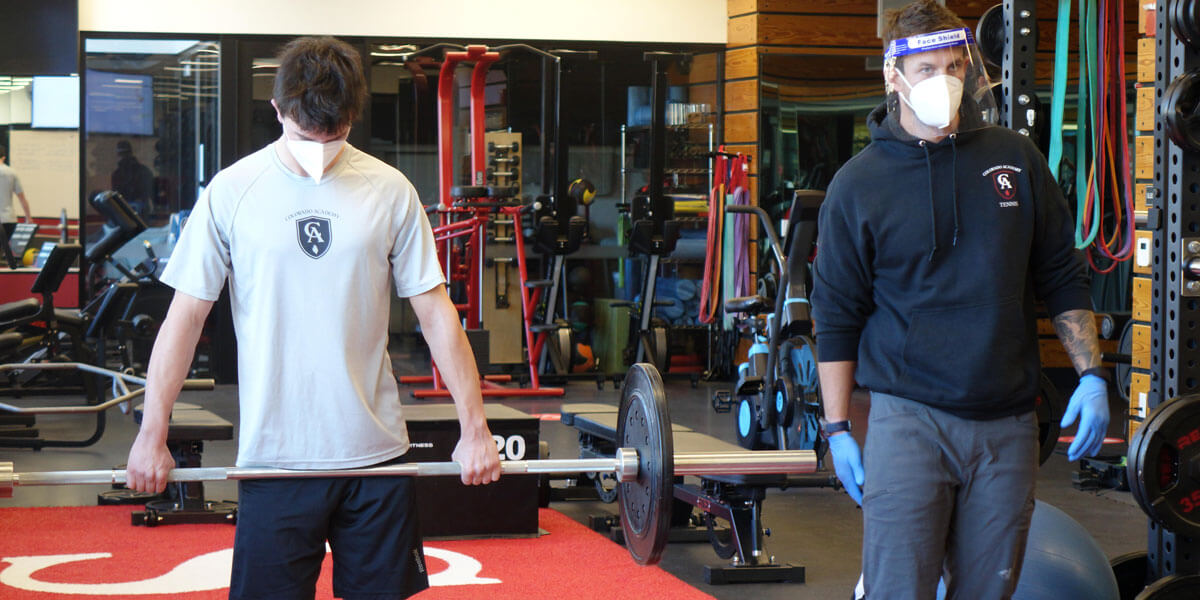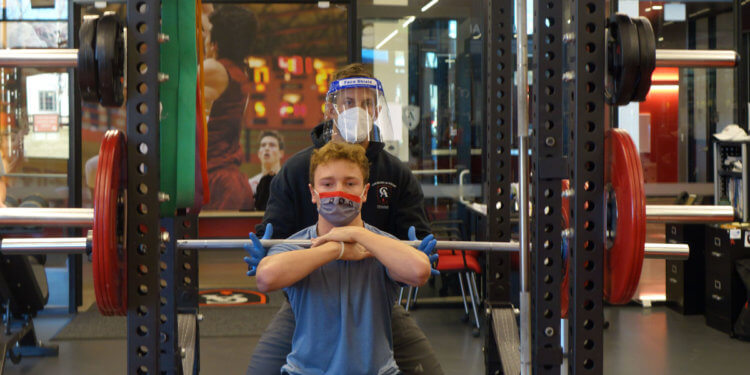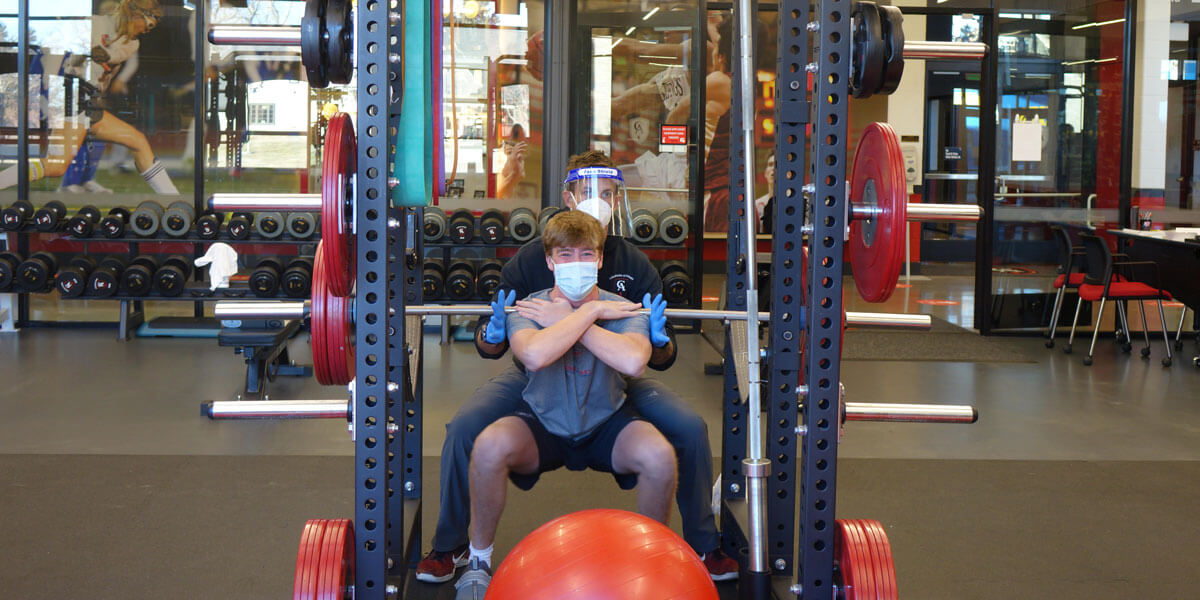
On a typical day after school, Colorado Academy Upper School students head for home, especially when the pandemic has canceled many after-school activities. But visit the Bansbach Strength and Conditioning Center at 4:15 p.m., and you will find Senior Chloe Brants, along with several other students, working out with Coach Wes Kirk.
Brants has committed to play Division III Field Hockey at Tufts University. Due to injury, she was unable to play for the CA Field Hockey Team that won the State Championship in fall 2019. Now, she’s working to build bone density and strength. “I feel like I am going to be safer on the field because of this hard work,” she says. “I am in better shape and less prone to injury.”
Ask her how she knows she is stronger, and she laughs. “Well, I have the calluses on my hands to prove it!” She also has the stats. When she started working out last year, she couldn’t lift a 40-pound weight. Now she can do a deadlift with 235 pounds.
Drop into the strength and conditioning center the next morning at 8 a.m.—before classes start in the Upper School—and you may run into Senior Garrison Ebel. He says that working out is “better than sleeping in.”
“I have a different level of focus after a workout,” Ebel says. “It prepares me for a day of classes, especially when I’m taking classes remotely.”

Ebel remembers the days when he could only do squats with 40-pound dumbbells. After months of working with Kirk, he now can do a squat with a 225-pound barbell. He has also added 20 pounds of muscle, and he is looking forward to Varsity Soccer season this spring because he will be “bigger and stronger.”
In a year when the high school athletic seasons have been rescheduled more than once to keep students safe during COVID-19, both students demonstrate the success of Kirk’s motivating philosophy. “We prepare as if the first game is tomorrow,” he says.
But keeping students active and fit during a pandemic has been no easy task. To accommodate COVID-19 safety protocols and student demand—he has 112 students in the strength and conditioning program—Kirk now opens the center to students for 10 hours a day.

Meeting demand
When the pandemic hit in spring 2020, Kirk knew he would need to abandon his usual program. He met remotely with high school and college coaches across the country to talk about ways to adapt strength and conditioning. The first step meant limiting the number of students who could be inside the Bansbach Center to eight, so that students could socially distance. Everyone has to wear masks, and Kirk also wears gloves and a face shield. “Masks are a strict policy,” Ebel says. “If you want to take the mask off to drink water during the workout, you have to go outside.”
But with only eight students allowed in the room, Kirk had to figure out how to meet the many requests from students who still wanted to work out, even though CA had waived its athletic requirement for the year. “There was a core group of students who fell in love with strength and conditioning last year,” Kirk says. “They can see and feel success in this space, and they are craving it.”
To meet demand, Kirk inaugurated a morning session that Ebel attends. He continued the after-school session Brants attends from last year. To accommodate the CA Flex schedule, which has Upper School students on campus only half the time, Kirk offers Sports Performance for credit all seven blocks of the day, meaning he coaches students from early morning to late afternoon, including Middle School students during the afternoon. Some students sign up to work out during their free blocks, even if they are not enrolled in Sports Performance.
Students clean equipment throughout the lift. At the end of their workout, the students clean everything they have touched—dumbbells, benches, bars. Kirk sprays off plates. Lacrosse balls, peanuts, and bands, which are used for warm-ups, are collected after every session and replaced with clean materials for the next session. At the end of the day, Kirk cleans all the equipment with an electrostatic spray disinfectant.
“Even before COVID-19, I always said this was one of the cleanest rooms on campus,” Kirk says. “Now we have taken it to a new level. We are cleaning so much that the equipment is showing the effects.”

Gratitude for a ‘great coach’
Because of the remote learning schedule, there might be weeks when students can only be in the center for one day. Kirk designed home workouts for all his students, tailored to the equipment they have available at home. He also worked with Upper School Counselor Liza Skipwith to create a 30-page booklet for students with guidance on nutrition, good sleep habits, and recovery from training sessions at home.
Ebel describes Kirk as a “great coach” who has helped him overcome back problems. “Being stronger all over, but especially with my core and back muscles, has helped a lot,” he says. “The stretching, the rolling out—yes, it hurts in the moment. But afterwards, you feel like you are floating.”
While it may appear that Kirk’s focus is on physical conditioning, he is well aware that many of his students show up for mental conditioning. The time they spend working out with him offers a reprieve from academic pressures. “All students have to worry about here is picking up a weight and putting it down,” he says. “And if they fail a set, they learn how to recover from failure.”
At the end of a workout session, Brants says she feels “recharged.”
“You can focus on something other than academics and it takes you out of reality for a period of time,” she says. “There is no room for your mind to wander, and by the end, with those endorphins hitting your brain, you feel better.”
The extra effort that Kirk has invested to continue building the strength and conditioning program during a pandemic has resulted in another positive side-effect—gratitude.
“Coach Kirk has the best interests of students in mind,” Brants says. “I’m so grateful to have him for a coach.”
